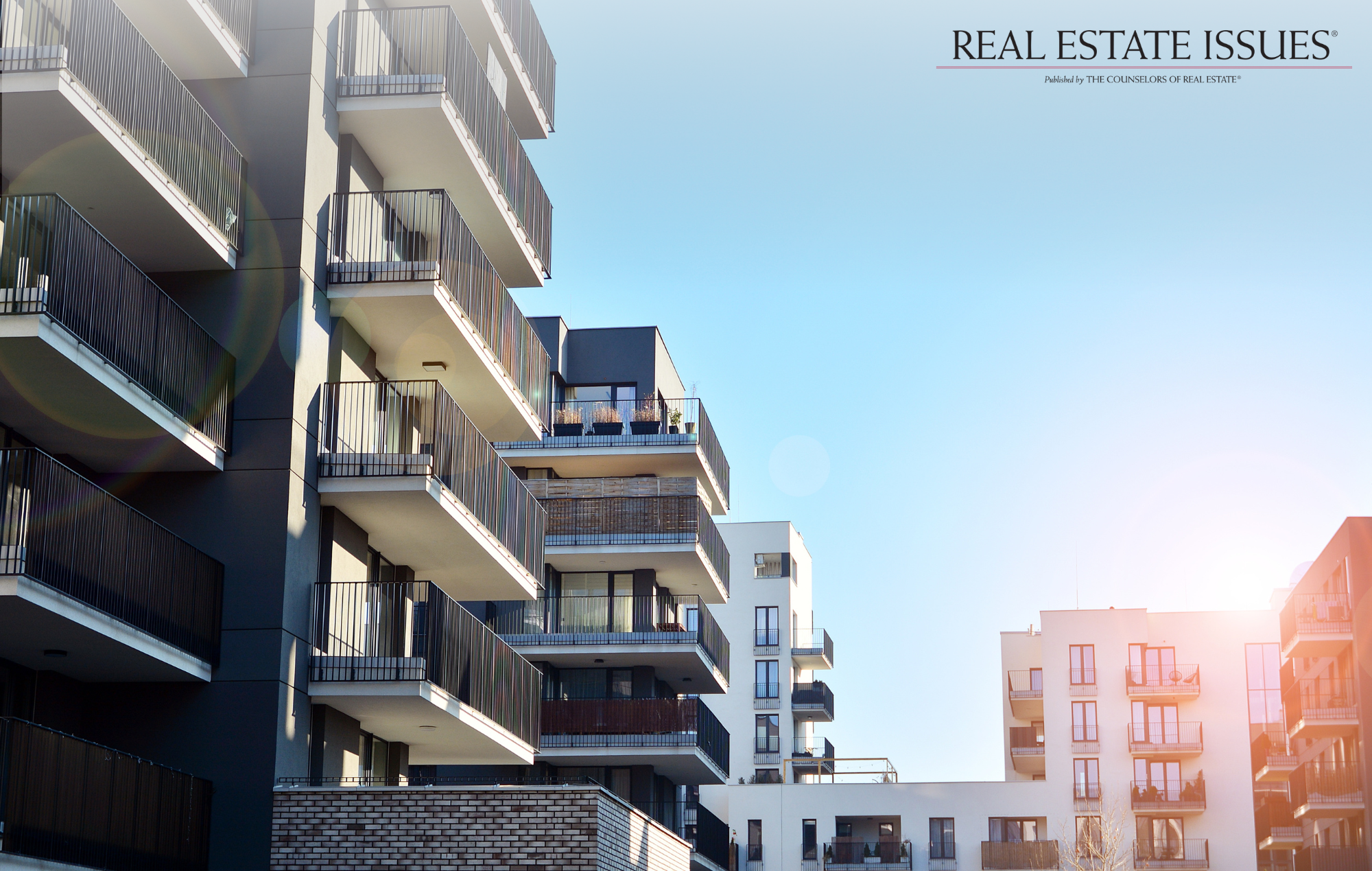Abstract:
As more retail activity goes online with Ecommerce and given the fact that the U.S. is over retailed, mall owners/developers are looking for ways to revitalize and monetize their real estate by adding multifamily to create a mixed-use environment. One of the main drivers of this effort is parking reduction, as developers and retailers have come to the realization that most shopping centers are over parked. There are many things to consider when attempting to incorporate apartments in a shopping area, not the least of which are regulatory issues and private land controls of other tenants/users in the center.
In Part 1, this article looked at the over-retailed status of the United States and many malls are dying particularly in the C and D categories, partly because of e-commerce, but mainly through the demise of department stores and other causes for the glut of retail real estate. As mall owners deal with this issue, they are turning to “extension strategies” to not only preserve value and reinvigorate these assets, but also to monetize the real estate and maximize its worth. Part 2 looked at one of those extension strategies, adding multifamily to dying malls and utilizing excess parking is one way of accomplishing that. Changing the mindset regarding parking ratios and retail parking requirements, the effect of zoning and other jurisdictional issues and the control that affected parties like other tenants and owners like department stores have through the operative documents like reciprocal easement agreements and other like documents.
In Part 3 of this article, a hypothetical example to revitalize a zombie mall will be explored, reducing required parking, and adding multifamily to the center. This can not only preserve the asset, but it can also make the center more valuable. As more centers lose anchors and become subject to market forces leading to their decline, strategies for making changes to drive these malls to greater viability become critical.
Part 4 of this article will review three case studies where parking reduction and adding multifamily to shopping centers has revitalized them and substantially increased their value.
Southdale Center
As mentioned in Part 1 of this article, [i] Southdale Center in Edina, Minnesota was the first enclosed mall in the US. The mall owner, Simon Property Group [ii] wanted to revitalize the center, as it was losing three of its four department stores in 2017. [iii] [iv] [v] JC Penney was replaced by LifeTime Fitness [vi], Restoration Hardware, a home accessories retailer took another of the department store boxes [vii], and the Hennepin County Library System located the Southdale Library in the third vacant anchor position.[viii]
As outlined in previous Parts of this article regarding excess parking, Simon realized it had underutilized land for remote parking on the periphery of the center that could be developed. In addition to revamping the mall, Simon added a Homewood Suites by Hilton [ix] in the northeast corner of the mall property, Shake Shack [x], a popular burger restaurant, in the northwest quadrant (see picture below) and relocated Restoration Hardware [xi] referenced above to the southwest quadrant.
These moves left a large tract of land available in the southeast corner of the mall property. Simon partnered with Stuart Company [xii], a Bloomington, Minnesota-based apartment owner/developer, to develop apartments and condominiums, and expanded retail on the site [xiii]. The result was One Southdale Place. [xiv] Notably, some of the selling points for this multifamily residential community are now close to fine dining and higher-end retail [xv]
According to Apartments.com, [xvi] monthly rents for One Southdale Place Apartments run between $1,495 to $2,885 per month. Average annual rents for these 232 units are $26,280 per unit or $6,096,960 in income per year. [xvii] Utilizing the methodology set forth in Part 3 of this Article, [xviii] the added value of these 400 units totals $121,939,200.
 Southdale Center 2010 [xix]
Southdale Center 2010 [xix]
 Southdale Center 2019 [xx]
Southdale Center 2019 [xx]
 One Southdale Place [xxi]
One Southdale Place [xxi]
NewPark Mall
NewPark Mall, [xxii] located in Newark, California, opened in 1980 as a “dumbbell” or two department store shopping center with Macy’s and Sears at either end and mall shops in between. It was built to serve the Tri-City area of Fremont, Newark and Union City. [xxiii] In the years following opening, NewPark Mall added several anchor boxes, including Mervyn’s in 1985; Emporium Capwell, a San Francisco –based department store chain operating under the name “The Emporium” [xxiv] in 1989 (Emporium Capwell was purchased by Macy’s in 1995 [xxv]); and JC Penney in 1991.
NewPark Mall includes over 1.1 million square feet of floor space and is anchored by Macy’s, JC Penney, Sears, and Burlington Coat Factory. Since it opened in 1980, it has been the largest enclosed retail center in Southwest Alameda County and one of the largest regional malls in the Bay Area. [xxvi]
At the time of its opening and for several years thereafter, NewPark Mall was the only game in town as far as malls went. Two competing shopping centers were developed: Union Landing [xxvii] in Union City, California, which opened in 1999, and Pacific Commons Shopping Center [xxviii] in Fremont, California in 2004. Both centers competed with NewPark Mall for tenants, and this included poaching tenants from NewPark.
The City of Newark understood it had a problem on its hands regarding NewPark Mall. In the Newark California General Plan adopted December 12, 2013, the following language appears under the heading “Major Community Goals” in the Planning Framework section of the General Plan: “Sustain NewPark Mall as a regional commercial attraction, while exploring opportunities for redevelopment of the surrounding area with civic and other uses supportive of the Mall.” [xxix]
In that same document, the city states, “Several of its (NewPark Mall, supplied) anchor tenants have closed or changed hands in recent years, including Target which closed in 2012. [xxx]
Changing retail trends and competition from newer centers such as Pacific Commons and Union Landing have diminished the mall’s pre-eminence in the region. This has prompted the city to explore innovative ideas for sustaining the Mall’s role as an essential part of Newark’s economy. The Mall has been Newark’s principal shopping area for three decades and is an important source of revenue and employment.” [xxxi]
The Newark California General Plan continues the narrative regarding NewPark Mall. “In 2012, the city began a visioning process for Greater NewPark Mall. The objective was to explore the unrealized potential of the area, along with ways to enhance the success of its retail businesses. Improving the retail climate around NewPark would not only provide economic benefits but create an exciting destination within the city. The General Plan calls for completion of the visioning process, to be undertaken collaboratively with property owners and local businesses, to explore options for achieving these outcomes. Ultimately, new land uses could be considered in the NewPark area to complement the area’s retail focus. Taller buildings may be appropriate in this area to create visual landmarks and accommodate a more intense level of development than would be appropriate in Old Town, Four Corners, and other commercial districts.” [xxxii]
According to the East Bay Times, after seeing only four houses built between 2000 and 2015, the city of Newark suddenly experienced a boom of residential development. Since the start of 2015, approximately seven hundred homes have been built, and approximately 1,400 have been approved or are under construction. The Newark City Manager, John Becker, said the housing boom is a major reason NewPark Mall’s owners invested in a major renovation. [xxxiii] “NewPark Place Specific Plan: The City, working in partnership with property owners, has developed a bold vision for the transformation of the NewPark Mall into the premier retail, restaurant, office, residential and entertainment place. A specific plan has been approved that will be the key tool to guide the transformation of the area. The City Council has now approved the NewPark Place Specific Plan.” [xxxiv]
The Plan as adopted by the Newark City Council on April 26, 2018, approved Brookfield Properties, owner of Newark Mall, to add an additional 1,519 residential units. [xxxv] Brookfield had previously been granted approval from the Newark City Council for 218 residential units adjacent to, but just outside of the approved mall redevelopment envelope. [xxxvi] [xxxvii]
The first phase of the Newpark Place residential development will contain 319 units. [xxxviii] According to Apartments.com, monthly rents for apartments in the Newpark Place market run between $2,483 and $4,020 per month. Average annual rents for these 319 units are $39,018 per unit or $12,446,742 in income per year. [xxxix] Utilizing the methodology set forth in Part 3 of this Article, [xl] the added value of these 400 units totals $248,934,840. Extrapolating that over the approved 1,519 units outlined infra, the total added value to Newpark Place could be as high as $1,185,366,840.
 NewPark Mall circa 2018 [xli]
NewPark Mall circa 2018 [xli]
 NewPark Mall conceptual plan [xlii]
NewPark Mall conceptual plan [xlii]
 NewPark Mall conceptual rendering [xliii] [xliv]
NewPark Mall conceptual rendering [xliii] [xliv]
Paradise Valley Mall
Phoenix-based RED Development owns Paradise Valley Mall in Phoenix, AZ. [xlv] It has been rebranded as PV. RED Development bought the mall from Macerich, a national operator of major malls and shopping centers, and some of the owners of the anchor stores, including Dillard’s and Macy’s, in 2021. The mall officially closed shortly after the sale, and most of the mall structure was demolished in July 2021. Costco and JCPenney remained open. [xlvi]
Phase I of PV includes a new retail area and a 400-unit apartment complex, which opened in October 2024 on the property called AVE Paradise Valley. According to Apartments.com, monthly rents for AVE Paradise Valley Apartments run between $1,669 and $4,890 per month. Average annual rents for these 400 units are $39,360 per unit or $15,744,000 in income per year. [xlvii] Utilizing the methodology set forth in Part 3 of this Article, [xlviii] the added value of these 400 units totals $314,880,000.
 PV Multifamily [xlix]
PV Multifamily [xlix]
Conclusions:
Mall owners, especially those with C– and D –grade properties in their portfolios, are looking for ways to harvest value from their centers and, at the same time, increase and, in some cases, restore the viability of these assets. As discussed in this article, adding multifamily to centers is becoming a popular method for accomplishing this goal.
There are many hurdles, and those owner/developers who find a way to make multifamily a part of their centers will reap a benefit, but those who incorporate it to make the center an effective mixed-use environment will benefit the most. According to the New York Post, nearly 200 US Malls had plans to add housing with dozens already completed or under construction. [l]
The ULI states, “Through creative visioning, planning, and development, it may be possible to find an ingenious and comprehensive community building solution that will have an impact far beyond the mall’s parking lots. When a mall falters, the question that needs to be asked is not “How can we save the mall?” but “How can we use this opportunity to create a higher value, more sustainable real estate development that helps build a more livable community?” [li]
Seth Shapiro, a principal with the urban planning firm Barton Partners puts it this way, “I think there is a default position, amongst many a retail developer, to just plop a residential project into a parking area… ignoring the need for place making and address that people look for when choosing a place to live.” [lii]
In the words of the consulting firm, Deloitte, in its article, The Future of the Mall, the mall must become a “new destination.” [liii] Most of all, the mall must become the new meeting place for the community—a multipurpose destination that offers extensive leisure activities as well as other functions, such as office, residential, and cultural amenities. Shops should be mixed in with other complementary uses, giving visitors an interactive experience in which the entire environment comes into play. Owners may need to rethink their rental models to allow for diverse types of retail experiences, such as short-term pop-ups or exhibitions. There is a great opportunity here to be innovative.” [liv]
The consulting firm, Kearney, says, “We see yesterday’s shopping centers and malls morphing into consumer engagement spaces (CESs)—transformed mixed-use commercial offerings designed to meet the needs of new and future generations of shoppers.” [lv]
Given the effect that e-commerce has on brick-and-mortar retail and the fact that the US is over retailed as a country, finding ways to engage in extension strategies will benefit not only the center owner, but also other stakeholders, such as the community. The tenants most likely to be targets for multifamily as part of a shopping center by demographic profile; singles, DINK’s, and seniors, will be attracted by the amenities available in a relatively self-contained environment.
As seen in this analysis, if shopping center owner/developers want to reap benefits from their real estate by adding multifamily, they will have some hoops to jump through.
Developers will likely need the buy–in of both AHJ’s, which might try to extract impact fees or other compensation, and major tenants with controls granted to them through the operative documents;, again perhaps requiring some type of payment or other item(s) of value such as trading the multifamily approval that the developer wants in the center for development rights or improvement funds for anchors for their properties, either at the subject location or at another center owned by the developer.
As the hypothetical example and case studies show, if the shopping center owner can free up parking through regulatory changes with the consent of the tenants with controls, adding multifamily can be a way to significantly revitalize the asset. If that does not happen, the center may find itself on a slippery slope from which it might likely not recover.
ENDNOTES
[i] https://cre.org/real-estate-issues/zombie-malls-part-1-bringing-dead-shopping-venues-back-to-life-through-multifamily-development-the-death-of-the-local-mall/
[ii] www.simon.com
[iii] Ewoldt, John (April 3, 2017). “Gordmans will close five stores in Minnesota”. Star Tribune. Retrieved June 26, 2017.
[iv] Ewoldt, John (June 2, 2017). “J.C. Penney will start closing sale at Southdale location on June 19″. Star Tribune. Retrieved June 26, 2017.
[v] . “Bon–Ton Stores to close (report)”. syracuse.com. Retrieved 2018-04-17.
[vi] Reilly, Mark (June 5, 2017). “J.C. Penney confirms it’s leaving Southdale; move makes way for Life Time (slideshow)”. Minneapolis/St. Paul Business Journal. Retrieved June 26, 2017.
[vii] www.restorationhardware.com.
[viii] “Southdale Library plans move to Southdale Center”. Sun Current
Edina/Richfield/Bloomington. Retrieved 2019-12-07
[ix] https://www.hilton.com/en/hotels/mspeihw-homewood-suites-edina-minneapolis/
[x] www.shakeshack.com.
[xi] www.restorationhardware.com
[xii] www.stuartco.com
[xiii] Buchta, Jim (July 8, 2013). “A first look at the luxury apartments under construction at Southdale Center”. Star Tribune. Star Tribune. Retrieved November 17, 2013.
[xiv] www.onesouthdale.com
[xv] Ibid.
[xvi] https://www.apartments.com/one-southdale-place-edina-mn/l3vgkvg/#l3vgkvg-0-photos
[xvii] https://www.apartments.com/ave-paradise-valley-phoenix-az/bvgfmn8/
[xviii] https://cre.org/real-estate-issues/zombie-malls-part-3-bringing-dead-shopping-venues-back-to-life-through-multifamily-development-a-hypothetical/
[xix] Ibid.
[xx] Ibid
[xxi] Ibid.
[xxii] www.newparkmall.com
[xxiii] https://malls.fandom.com/wiki/NewPark_Mall
[xxiv]https://www.riceandbeansvintage.com/blogs/the-vintage-designer-fashion-guide/history-of-emporium-san-francisco-s-premier-high-end-department-store. See also: https://en.wikipedia.org/wiki/The_Emporium_(San_Francisco)
[xxv] Ibid.
[xxvi] https://www.newark.org/departments/community–development/specific–plans–masterplans/greater–newpark–master–plan/–fsiteid–1
[xxvii] Unionlanding.com. See also: https://en.wikipedia.org/wiki/Union_Landing_Shopping_Center
[xxviii] www.pacificcommons.com
[xxix] https://www.newark.org/departments/community-development/newark-general-plan
[xxx] Ibid.
[xxxi] Ibid, p. LU-27 and 28.
[xxxii] https://www.eastbaytimes.com/2017/11/17/newark-housing-boom-is-a-needed-boon-for-city/ 138 https://www.newark.org/departments/community–development/specific–plans–masterplans/greater–newpark–master–plan
[xxxiii] Ibid.
[xxxiv] Ibid, p. 2-22.
[xxxv] https://www.reporternewspapers.net/2019/02/07/mall–parking–lots–become–prime–real–estatefor–new–development/
[xxxvi] https://www.newark.org/departments/community–development/specific–plans–masterplans/greater–newpark–master–plan
[xxxvii] https://www.brookfieldpropertiesretail.com/properties/property–details/newpark.html
[xxxviii] https://www.newark.org/departments/community-development/specific-plans-master-plans/greater-newpark-master-plan
[xxxix] https://www.apartments.com/ave-paradise-valley-phoenix-az/bvgfmn8/
[xl] https://cre.org/real-estate-issues/zombie-malls-part-3-bringing-dead-shopping-venues-back-to-life-through-multifamily-development-a-hypothetical/
[xli] Google Maps, NewPark Mall, Accessed 13:15, April 28, 2020.
[xlii] See Endnote 28, p. 2-29.
[xliii] https://www.brookfieldproperties.com/en/our-properties/newpark-mall-381.html
[xliv] https://jkdesigngroup.com/portfolio/newpark-place/
[xlv] https://www.reddevelopment.com/properties/pv/
[xlvi] https://www.azcentral.com/story/news/local/phoenix/2024/06/13/whats-new-when-paradise-valley-mall-reopens-as-pv-this-fall/74071543007/
[xlvii] https://www.apartments.com/ave-paradise-valley-phoenix-az/bvgfmn8/
[xlviii] https://cre.org/real-estate-issues/zombie-malls-part-3-bringing-dead-shopping-venues-back-to-life-through-multifamily-development-a-hypothetical/
[xlix] https://reddevelopment.propertycapsule.com/web/property/a9514de25630af4f306febab6006c828-6791b1024d45f625765b31fd8e9296aa#overview
[l] https://nypost.com/2024/12/09/real-estate/underutilized-malls-are-becoming-housing-units/
[li] https://uli.org/wp-content/uploads/ULI-Documents/Tp_MAll.ashx_.pdf
[lii] Conversation with Author.
[liii] https://www2.deloitte.com/content/dam/Deloitte/ca/Documents/consumer-industrialproducts/ca-future-of-the-mall-en-AODA.pdf.
[liv] Ibid.
[lv] https://www.kearney.com/consumer-retail/article/?/a/the-future-of-shopping-centers-article


 @Grand Warszawski/Shutterstock.com
@Grand Warszawski/Shutterstock.com



